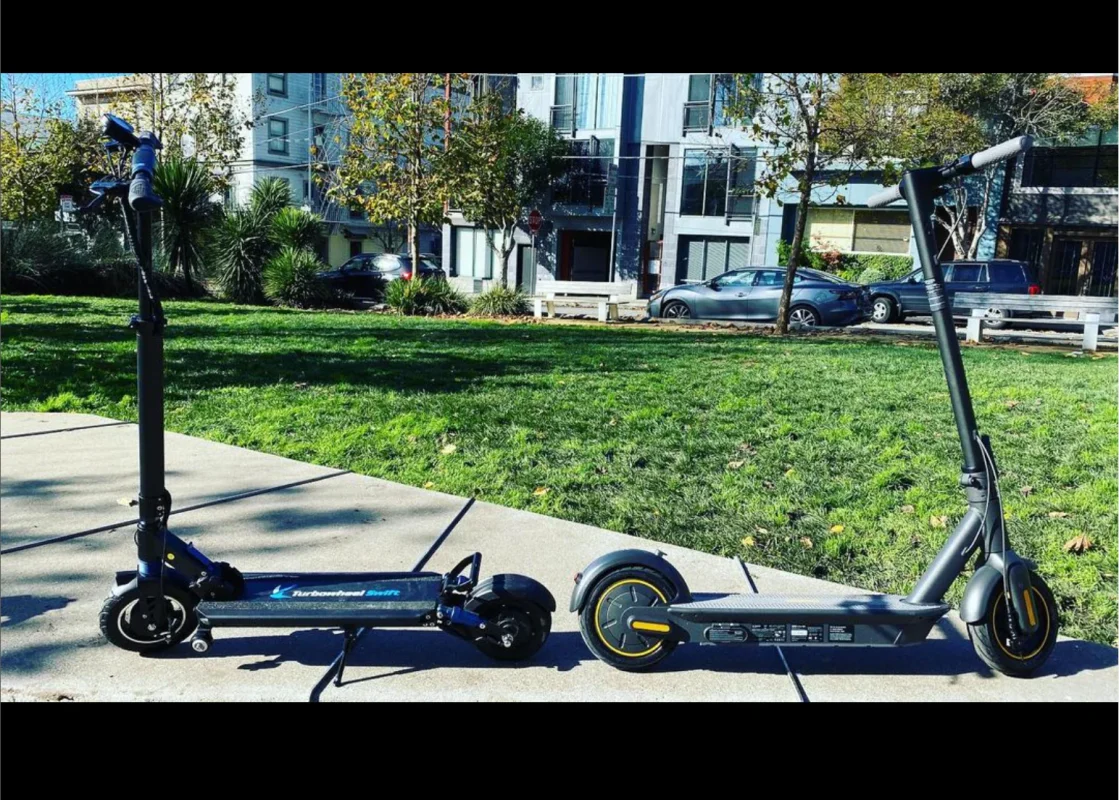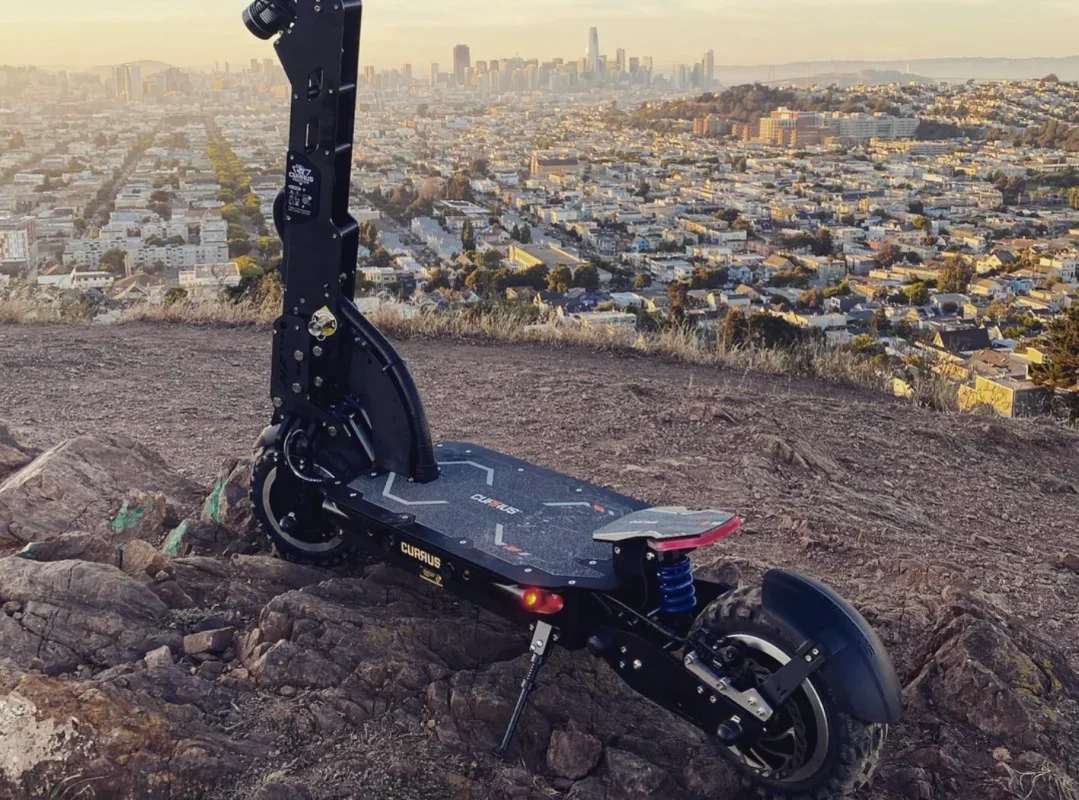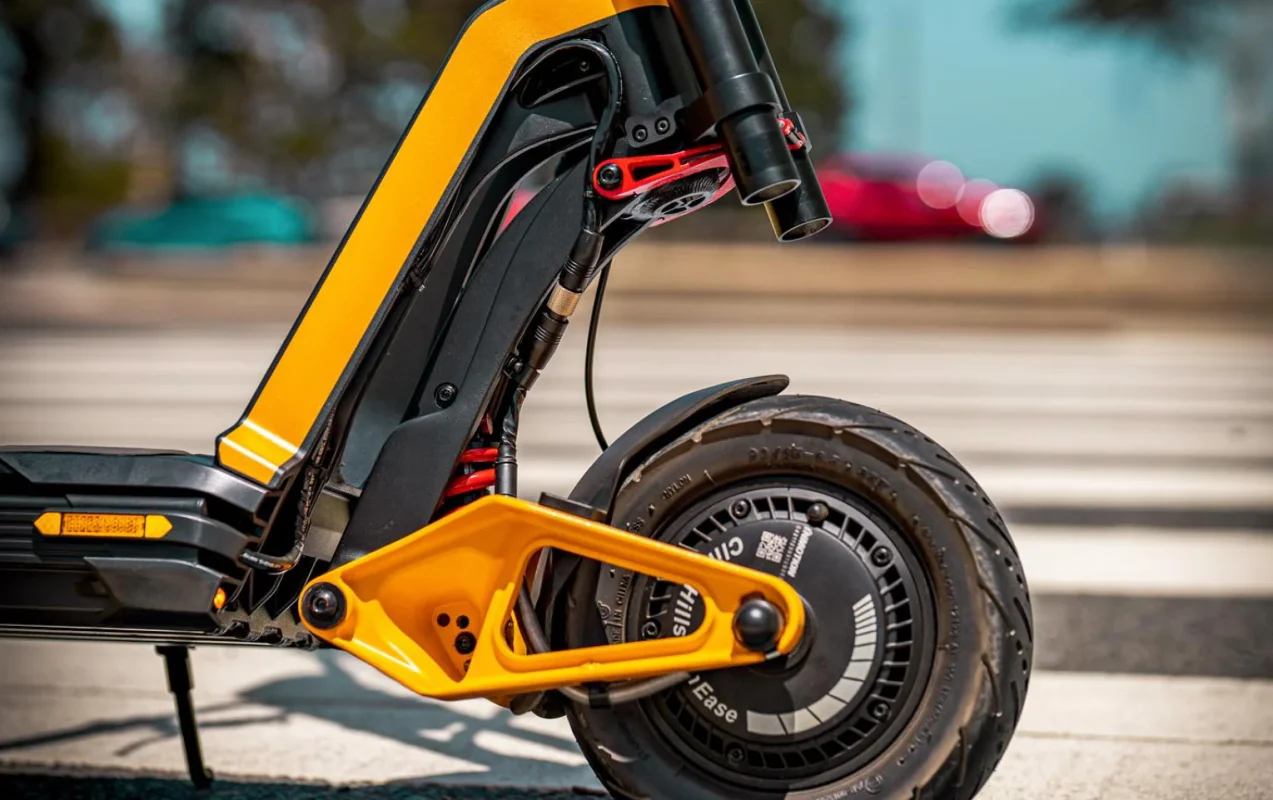E-Scooter Buying Guide: How to Choose the Best Commuting Scooter Commuting to work isn’t the most exciting thing that happens in our day, but that doesn’t mean it has to be boring. If you’re looking for a way to make your commute more fun, efficient, and eco-friendly, consider adding an electric scooter to your routine. Here’s what you might need to consider, as well as some options for you to explore. Why use an e-scooter for commuting? E-scooters are a great choice for commuters in cities and towns for a variety of reasons. To start with, e-scooters are lightweight and compact, as they generally weigh between 30 and 60 lbs and are able to fold down nearly flat, taking up only a few feet of space. This makes them perfect for taking with you to office jobs or school, and for use in combination with public transit. Additionally, e-scooters are quick and safe. With speeds ranging around 20-30 mph on average, they can keep up with both pedestrian traffic and light in-town vehicle traffic. On top of that, most modern e-scooters have built-in safety features like strong suspension, lighting, and improved braking. Finally, e-scooters are fun! They’re a great way to speed up your commute while also allowing you to enjoy the sights and sounds along it in a comfortable fashion. How to choose the best commuting scooter A reliable and durable commuting scooter can make your daily commute more enjoyable and eco-friendly. When choosing an e-scooter for commuting, here are a few factors to take into consideration. Lightweight scooters will transport easier, while heavier models will be able to carry more cargo and generally be more stable. For city commuting, especially at night, options for lighting and reflection are important safety features that shouldn’t be overlooked. This can help you see and be seen in low-visibility situations such as night commutes, fog, or heavy rain. Speed is generally less important than range for commuter vehicles. You’ll want to be able to make it at the very least to your office on one charge, even better if you can make the round trip in one go. Additional safety and convenience features like wider footboards, improved suspension, and external battery availability might be worth looking into if you plan to use your commuter scooter frequently or in more challenging conditions. The safety rating or IP rating of your scooter matters quite a lot if you live in an area that gets a significant amount of rain or an area with lots of dust and debris on the roadways. Look for a model with an IP56 or higher rating. Best commuting scooter examples Here are some of the best examples of e-scooters designed with commuters in mind. The VSett Mini is a great ultra-lightweight option for inner-city commuting. With a weight of just 30 lbs and a compact frame complete with solid tires to eliminate flats as a possibility, it’s perfect for use in combination with public transport. The InMotion Climber not only has an impressive 34-mile range and high IP rating for both the body and battery, but also the capability to climb up to 36% slopes with ease and safety. This makes it a great commuter option for hilly areas with steep inclines on streets. The VSett 11+, an improvement on their Zero 11’s frame, has improved front and rear suspension and a solid 330 lbs max load, making it great for commuters who are heavier or who need to carry more gear with them to and from work. It also has an impressive 60-mile maximum range. Conclusion E-scooters can make fantastic commuter vehicles. You just need to know what you’re looking for to get the most out of these eco-friendly rides. If you’re interested in exploring your e-scooter options, Alien Rides has a great selection from some of the best brands in the industry for you to choose from. With the newest models, all tested in-house, you’re sure to find something that suits your commute from top to bottom, and you can rest assured that you’re getting exactly what you’re seeing.
Tag Archives: scooterlife
Onewheel Vs EUC: Key Differences and Similarities The world of electric vehicles is quickly evolving. New models and designs come out every year, challenging the existing spectrum of personal electric vehicles, including electric unicycles. One such competitor is Onewheel, an innovative electric vehicle that takes the single wheel of an EUC and repurposes it in a sleeker model. But are these vehicles worth it? Here’s what you need to know. What is an EUC? An electric unicycle, often abbreviated to EUC, is a personal electric vehicle that consists of one central wheel with a motor on top and foot pedals on either side that the rider uses to balance and steer. The exact design varies from model to model and between manufacturers but is largely consistent in terms of size and operation. The first EUCs started appearing in the late 2000s, though the first commercially available EUC didn’t hit the market until 2010. This was the Solowheel, created by Shane Chen. The EUC market boomed between 2014 and 2015, with major names like InMotion, King Song, Gotway, and Ninebot putting out their first lines and solidifying the competition in the scene. Now, there are many reliable and interesting EUC manufacturers to choose from, each with their own benefits. The average electric unicycle can go around 20-30 mph comfortably, though some have top speeds as high as 50 or 60 mph. They typically have a range of about 35-40 miles on a single charge. These vehicles are often used as recreational or commuter vehicles by those who live in urban areas and are becoming a more popular personal transportation choice as the market grows. They don’t typically need much in the way of aftermarket accessories, though many come with additional features including lights, Bluetooth connectivity, and specialized foot pedals. What is Onewheel? Onewheel, created by Kyle Doerksen in 2013, is a personal electric vehicle resembling a skateboard. But, instead of having two sets of two wheels attached to the bottom of the board, Onewheel has, well, one wheel directly in the center of the board, which is exposed on top. Physically, the Onewheel differs from an EUC in that its central wheel is exposed rather than covered by the motor, which is instead built into the board itself. It has a sleeker profile than most EUCs and sits lower to the ground. There are three models available – the Pint, GT, and Pint X – all of which have the same general design but vary in terms of range and top speed. The Pint has a 6-8 mile range with a 16 mph top speed. The Pint X, the most popular model, has a 12-18 mile range and an 18 mph top speed. The GT, Onewheel’s flagship model, has a 20-32 mile range and a 20 mph top speed. The company also sells various accessories to go with their boards including fenders, extra chargers, rail guards, and stands, among others. Onewheel vs. EUCs As you can see, Onewheel vehicles are not as powerful as most EUCs. They tend to have shorter ranges and lower top speeds. This makes them fine for shorter commutes or recreational riding, but an EUC is likely the better choice for more regular or longer-distance travel. Interestingly, at the heart of both Onewheel and EUCs lies a shared technological foundation: the self-balancing mechanism. Using gyroscopes and accelerometers, both devices continuously track the tilt and direction, adjusting the motor inputs accordingly to maintain balance. This intricate marriage of hardware and software offers riders that distinctive sensation of floating, regardless of whether they’re on an EUC or a Onewheel. Additionally, Onewheel has come under fire recently due to issues with its electrical systems, and though the company is working to resolve these issues, it is still worth noting when making the decision between the two products. Beyond this, EUCs have a wider range of models and customization options than Onewheel does due to the fact that EUCs aren’t limited to one specific company. Onewheel’s designs may be innovative and unique, but they are also extremely specific and may not be the best fit for all riders. Still, Onewheel’s vehicles are an interesting option that is worth watching as they advance and evolve over time. Conclusion Interested in trying out an EUC? Alien Rides has a wide range of models from the leading brands in the industry for you to explore. With vehicles for every purpose – from sport riding to everyday use – and a rigorous testing process to ensure you’re getting the best product every time, Alien Rides has something for almost everyone to love.
Top 5 Cities to Ride Electric Scooters Electric scooters are gaining popularity over the course of the last decade and for good reason. To begin with, electric scooters are a more affordable option for many commuters. On top of being priced on average hundreds of dollars less than the cheapest motorcycles and cars on the market. They’re also cheaper to maintain, with minimal charging, repair, and maintenance costs. Additionally, for those who do not want to own an electric scooter and for whom it may not be practical, there are scooter rental services in many major cities that offer transportation at a reasonable daily or hourly rate. Electric scooters are also better for the environment and for our health. They run on electricity, which reduces the need for harmful fossil fuels in a commuting and recreational environment. Additionally, research suggests that riding an electric scooter can have a variety of benefits on your health from improved balance to better immune systems and less stress on the body. Beyond all of this, riding an electric scooter is fun! It’s a great way to inject some novelty and enjoyment into otherwise boring daily travel and to encourage new hobbies with distance and sport riding. Top 5 cities for electric scooters Here are the top five cities in the United States for electric scooter riders. Portland, Oregon Portland has had e-scooter traffic since 2017 when the scooter boom first started. This arts-loving city fully embraced the environmentally friendly alternative for their tourism industry, implementing designated streets and lanes for scooter use as well as multi-use paths in parks for sport riding. With an ever-improving walkable design, this city is great for outdoor enthusiasts and those new to scooter riding. Denver, Colorado E-scooters had a bit of a rocky start in Denver, which didn’t adopt the trend immediately or have much success with it until Lime, the e-scooter rental service, developed a new fleet of machines specifically designed to handle the harsh Colorado winters. Since then, this environmentalism-loving city has fully embraced the micro-mobility movement and is taking steps to implement new infrastructure to support it, including new scooter docks placed at convenient intervals around the city. Atlanta, Georgia Being the home to the busiest international airport in the world, Atlanta has to have a robust public transportation infrastructure. With the MARTA, streetcars, and bus systems connecting the city, larger transportation is covered, but the city is also improving its personal vehicle infrastructure every year. As of the writing of this article, Atlanta hosts four different e-scooter rental companies – Bird, Helbiz, Spin, and VeoRide – with an openness to adding more. They are also building in more and more resources for e-scooter riders specifically including charging stations and docks, as well as PEV lanes and paths in the city’s parks and public spaces. Santa Monica, California Santa Monica is a beautiful oceanside city with a thriving tourism industry. As such, it has a considerable and ever-improving public transportation system including e-scooter rental services from Spin, Veo, and Wheels. The city’s piers, boardwalks, and outdoor malls all have excellent wide walkways for PEV movement and there are many personal vehicle lanes available for use. Austin, Texas Austin is a large, sprawling city where sometimes just walking isn’t your best option. But with a solid public transportation system in the form of the Capital Metro and strong biking and PEV lane presence, using an electric scooter in the city is a great solution. Additionally, you can download a bike map that shows all of these lanes from the Austin government website. Washington DC Washington DC has always had a reputation of modern progress as the nation’s capital, and that holds true with transportation. Its infrastructure for public transport, with the DC Circulator and the Metro systems, as well as the streetcars, is solid and hailed as one of the best in the United States, so it shouldn’t come as a surprise when you learn that DC’s walkable infrastructure is amazing as well. There are plenty of designated bike and scooter lanes to use for safe riding and lots of scooter docks to charge and rent from. Conclusion Looking to get into electric scooters? Alien Rides has you covered. Explore our range of high-quality, industry-leading models for commuting, long-distance, sport riding, and more. With an intensive review process and rigorous quality assurance standards, you can trust that you’re getting the best ride every time with Alien Rides.
The Costs of Owning an Electric Scooter: Cheaper than a Car? Electric scooters are a fun and easy way to make your commuting more environmentally friendly, but are they also budget-friendly? Cars have been the industry leaders for private transportation for a century, but they can be incredibly expensive. Electric scooters might be a more economical choice when you break down the costs. Here’s what you need to know about the costs of owning an electric scooter, and how they might be cheaper than owning a car. The Costs of Owning a Car According to the popular budget and money management company NerdWallet, the average annual cost of owning a relatively new vehicle that sees regular use is roughly $10,700 as of 2022. However, this may not consider the initial costs of buying a car and may not cover lifetime maintenance costs. Initial costs The average cost of a new car in 2022 was around $47,000. For a used car, you could expect to pay slightly less, at $33,000. This is largely attributed to the rising cost of inventory and inflation, especially in the United States. After buying the car, though, you’ll have to register it and pay your taxes for it. This includes the actual vehicle registration fee (the fee for filing your insurance and proof of purchase with the state), the dealership fee if you happen to buy your vehicle at a dealership, the cost of getting your driver’s license, and the tax rate for your vehicle (which is an annual recurring cost). On average across the United States, this is about $2,781 for a new vehicle or $2,081 for a used vehicle (with about $100-$300 in renewal fees annually). Initial investments for owning a car are incredibly high and likely to only go up from here. Fuel The most common fuel type for cars in the United States is gasoline, which averages around $3.60 per gallon nationally as of writing. If the average vehicle has a 12-gallon tank and you fill it roughly once every ten days (in line with national averages), then you’re spending about $130 in gas per month. That’s $1,560 per year. If you drive a diesel vehicle, you’re spending even more. Diesel costs on average around $3.90 per gallon as of writing, meaning, if you’re using the same size tank and filling it just as often as you would a gas vehicle, you’re spending around $140 per month and $1,685 annually. What about electric vehicles? The cost to recharge an electric vehicle at a public charging station is roughly $12 to $16, which sounds good until you realize that you’ll need to recharge your electric car about 2-3 times per week, costing a total of $36-$48 per week or $1,872-$2,496 annually. This can of course be factored into your monthly electricity bill if you are charging at home, though this does require a home charging station, which may incur extra costs. Maintenance Maintaining a car varies in difficulty depending on a couple of factors, including the age of the vehicle and your location. Generally, though, you’ll be paying regular maintenance costs for things like oil changes and tire rotations. NerdWallet estimates that the average car owner pays about $121 per month in maintenance costs for a new vehicle. That being said, you will also need to make larger repairs every few years or every 10,000 miles or so. These might include new tires, air filter replacements, and brake pad replacements. Assuming you only need these done every five years or so, the total cost to replace all of these can vary from about $330 to upwards of $1,450. You might also have major unexpected costs like flat or blown tires, transmission concerns, weather damage, overheated engines, failed batteries, broken starters, or even collision damage. These can cost several thousand dollars each in repairs depending on the severity of the issue or may total the car completely. Thankfully, many major costs are covered by warranties from car manufacturers, but they can be incredibly costly if the warranty runs out or is voided for any reason. Insurance Insurance is legally required for all vehicles in the United States and in many countries. The cost depends heavily on the kind of coverage you’re looking for as well as your driving record and credit history. Nerd Wallet provides this helpful chart with averages. Driving and credit history Average annual cost of full coverage Average annual cost of minimum coverage Good driver with good credit $2,148 $685 Good driver with poor credit $3,455 $1,118 Driver with an at-fault accident and good credit $3,164 $1,044 Driver with a recent DUI and good credit $3,933 $1,403 Lifespan and Total Costs According to most modern research, the average car in America will last its driver around 12 years or 200,000 miles. If your car is really well-maintained and new when you buy it, though, it might last as many as 300,000 miles and/or upwards of 20 years. This is fairly rare, however, and requires diligent daily maintenance and regular mechanic visits throughout its lifetime. So, if we consider the average car to be new on purchase, gas-powered, with minimum insurance coverage for a driver with a good record and good credit, and with an average lifespan of 12 years (assuming it stays within warranty the entire time), the total lifetime cost of owning a car in the United States comes out to about $113,561 at the lowest. The Costs of Owning an Electric Scooter It’s difficult to find an estimate for the lifetime costs of owning an electric scooter, given that they are a much newer method of transportation than cars. That being said, we can break down the cost into the same categories we used before to compare them on a relatively equal footing. Initial costs Scooters generally cost somewhere between $300 and $2,000 depending on the kind of scooter you’re buying. Electric Scooter Insider breaks down the initial cost of buying a scooter using this category chart. Category Price Range Budget $300 – $700 […]




